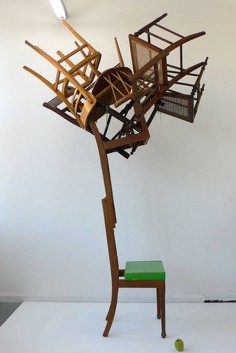KAREN RYAN
קארן ראיין
卡伦瑞安
카렌 라이언
カレン·ライアン
КАРЕН РАЙАН

source: assentodiario
“Necessity, fate, autobiography and subversion are the key influences upon my practice. I use materials that are provided as a product of continuous waste driven by mass consumption and fashion. There are enough mass produced chairs in this world: I collect discarded and unwanted ones from the street, car boot sales, jumble sales, second hand shops and charity shops. I then make ‘new’ chairs with these chairs. They are naively constructed ntentionally to recapture the adventure of childhood.”
Karen Ryan
.
.
.
.
.
.
.
source: designboom
British designer karen ryan presents her latest ‘custom made’ chair, a project she began in 2005. drawing from the history of discarded objects, this chair recycles mass-produced chair components. Ryan’s first encounters with raw materials such as broken televisions and dilapidated chairs were in a long alleyway
behind her grandmother’s flat. realizing that the furniture from her childhood is now being discarded, ryan aims to subvert
the cycle of consumer culture and preserve the memories embedded in existing objects.
the chairs are sprayed colours influenced by my past love of enameled corgi toy racing cars,’ says ryan. ‘custom made’ chairs are my adult go-carts.’
.
.
.
.
.
.
.
source: ballooncontemporary
Karen Ryan is a contemporary British designer based in Portsmouth, England. She completed her Masters in Arts in Design Products at the Royal College of Art under Ron Arad. Often described as a “design agitator” working on the fringes of the design world and subverting accepted categories, her work anatomizes existing objects and reconfigures them according to complex personal narratives and obsessional themes. Her work is the subject of several recent publications, has been the subject of exhibits in Milan, London, Paris, and Belgium, and is often heralded as an exemplar of green design and recycling due to her use of pre- existing materials in a non-industrial context. However, Ryan’s motivations run much deeper and involve a critical reframing of the very notion of the useful and the useless. Objects, most often cast- offs sourced at thrift stores or scavenged as valueless detritus from the streets, find a redemptive second life as protagonists in a sustained attack on “taste” and its role as a mark of social distinction. Concerned with re-inscribing social reality back into an exhausted circuit of aesthetic exchange preoccupied with luxury, Karen Ryan’s work radically questions social and class categories and their relation to the aesthetic by looking at what loses aesthetic value and is discarded over time, despite retaining functional value. Along with narrative concerns she explores through her practice the collective fantasy of a kind of zero point in design, subverting modernist canons and notions of production.
.
.
.
.
.
.
.
source: treehugger
Karen Ryan is an English artist and furniture maker whose work hasn’t been seen in a while. Last noted at the London Design Festival in 2007, she is back now with a series of chairs pieced together from…other chairs.
Throughout the city of Portsmouth, England, she has placed her re-assembled remnants of chairs in abandoned locations, fields and alleyways, so that they look like dead bodies. Ryan is known for her use of recycled objects in her work. Other projects have used old chairs stuck together, but in this exercise, called body, she has taken it to the limit. She has collected discarded chair frames, taken them apart and then re-assembled them in a macabre fashion. This TreeHugger wrote to Karen Ryan, asking her the who, what, where and why of her project. Her answer was enigmatic: “It is intentional that I have only put the title ‘Body’ installation locally in Portsmouth, so I am sorry but I can not give you further text.”
They are everywhere you wouldn’t want to go: abandoned fields, back alleys, garbage strewn paths. So if you are in Portsmouth, let us know where to find them. Karen Ryan also works with old, antique and discarded plates. She finds them in charity shops. She is more forthcoming about her modus operandi: she removes “the decorative patterns that camouflage our everyday lies. In its place I leave words that prick our conscience and create portraits of hidden domestics left open for others to interpret.”

